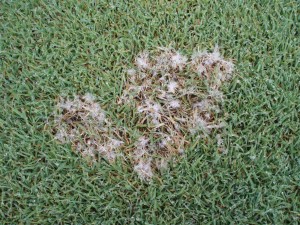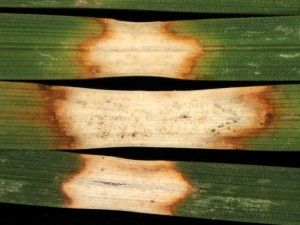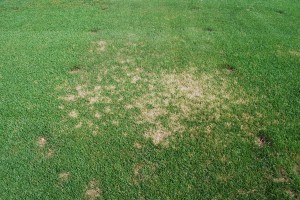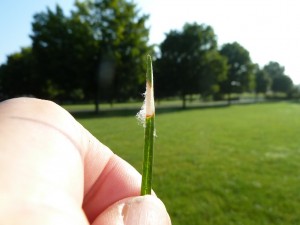… summertime gonna come and go by and by. As the weather changes from the dog days of summer to a more “fall-like” pattern, I am feeling pretty good; but so is the fungus that causes dollar spot.
The reality is that most of us have been seeing dollar spot off and on all year. The disease is caused by the fungus commonly known as Sclerotinia homoeocarpa (a name change is in the works), and is considered to be a spring and fall disease of cool season turfgrass species. The fungus reportedly grows best within a temperature window from 59º to- 86ºF. That said, I’ve seen samples of active dollar spot in our laboratory at temperatures as low as 32ºF and as high as 100ºF, so it is my opinion that temperature is not the primary driving factor in disease activity.
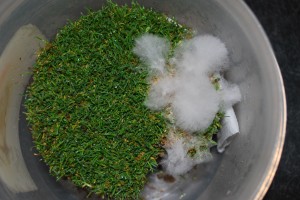
Dollar spot – crazy mycelial growth after a night in a very wet incubation chamber. Photo: Sabrina Tirpak, Rutgers PDL
If temperature is not the most reliable predictor of disease activity, then what drives the pathogen? Most reports suggest that outbreaks of dollar spot are strongly tied to extended leaf wetness. Eight to- twelve hours of continuous wetness in the turf canopy and the potential for disease activity increases dramatically. Most predictive models for dollar spot strongly depend on rainfall, humidity and dew measurements. In fact, recent research efforts at cultural control of dollar spot on golf courses have focused on dew removal and moisture management with a fairly high degree of success. Temperature might be less important, but it is not benign – clearly the fungus grows best in the 59º to- 86ºF window. An important temperature related factor, however, is that wide swings in temperature, like those we see in September and October in New Jersey, from cool nights (50s) to warm days (80s), usually result in significant condensation and dew formation in the turf canopy, particularly in taller cut landscape turf situations. Longer periods of wet grass = more disease activity. Walk me out in the morning dew and we will soon find some dollar spot.
Outbreaks of dollar spot are actually easy to spot. Small dead spots of grass with abundant spiderweb-like mycelium growing among the leaf blades are good indicators of disease. The fungus kills grass “white” and often causes whitish leaf lesions with reddish-brown borders. The leaf lesions are described as “hour-glass” or “bow tie” shaped, which is up to your imagination. Lesions do, however, mostly cover the whole leaf blade. With severe disease activity, dead spots coalesce and larger areas of turf thin and die.
Control of dollar spot is easier said than done. Generally speaking, research since about 1920 suggests that cultural practices that produce a vigorous turf stand will help minimize the disease. Seriously, the late Dr. Houston Couch published a paper in 1960 that suggested turf plots with higher nitrogen inputs that were maintained with soil moisture levels at field capacity had less dollar spot. Adequate nitrogen and water and there was less disease, go figure!
The moral of the story is simple; improve your turf culture and improve the ability of the turf to resist or tolerate the pathogen. At the same time, manage leaf wetness to create conditions unfavorable to the pathogen. I’ll sing it again; use basic concepts in plant pathology, optimize plant health and minimize pathogen growth, and you will see less disease all around.
Become a good agronomist and you won’t have to become a pathologist. (There’s only room for one of us in this town!) And wave that dollar spot flag, summertime gonna come and go by and by…

